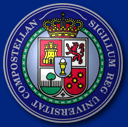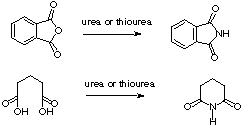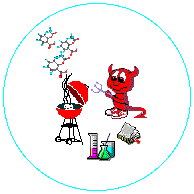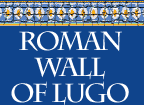[E0008]
 |
A Microwave and Conventional Heating Comparative Study |
 |
Julio A. Seijas*, M. Pilar Vázquez-Tato* and Carlos Álvarez-de-Gabriel
Received: 27 July 2001 / Uploaded 7 August 2001
Imide
group is an interesting functionality, due to its wide presence in the natural
products pool and in the pharmacologically active compounds. This has attracted
our attention as a target to be prepared by microwave irradiation. We had
published a general approach to N-substituted cyclic carboxylic
imides [1], and later we extended our
studies towards non substituted cyclic imides, thus we developed a new synthesis
of thalidomide enhanced by microwave heating [2]. Thalidomide, an old drug with
a renewed interest, has two imide groups in its structure. We carried out two
microwave mediated new approaches: a stepwise synthesis by preparing first
N-phthaloyl-L-glutamic acid and later using urea or thiourea (as the source of
nitrogen) to close the glutarimide ring (scheme 1, right) and a one step
reaction (scheme 1, left) from L-glutamic acid, phthalic anhydride and thiourea
in the latter, obtaining with this procedure thalidomide in a 60% yield with the
formation of the two imides simultaneously.
A
feature that attracted very much our interest was the fact that when urea was
used instead, we obtained a lower yield of thalidomide and a considerable amount
of pyroglutamic acid. This, compared with the previous results for the formation
of imides in the only study we know on urea and thiourea [3] resulted in a reversed
reactivity.

SCHEME 1
We
decided to study independently the reaction of formation of phthalimide and
glutarimide in the reaction conditions used for thalidomide, to check if there
was any marked difference between formation of phthalimide and glutarimide rings
(scheme 2) which were the responsible for the good behaviour in the preparation
of thalidomide.

SCHEME
2
Thus we studied the formation of glutarimide by heating glutaric acid with urea
and with thiourea. We found that after 15 minutes irradiation in the (domestic)
microwave oven (Electrolux; 1000W, 70%) we obtained, 90% yield of glutarimide
with urea, and 98% yield with thiourea. We also carried out both experiments in
a preheated heating mantle (160ºC) for the same time as they were irradiated,
getting a 50% yield for the reaction with urea and a 33% when thiourea was used.
The phthalimide formation from phthalic anhydride
was studied in a similar way. The reaction with urea was irradiated for 6
minutes with a quantitative yield of phthalimide. Meanwhile, with the heating
mantle it gave just 43% yield of imide. The use of thiourea with microwaves gave
a lower yield of phthalimide (91%, and required 10 minutes irradiation), but
with the heating mantle it was slightly higher (46%) than the conventional using
urea.
Regarding to the improvement on the synthesis
by microwave of our three component reaction for thalidomide, we think thiourea
is less reactive than urea towards phthalic anhydride than urea, which could
help to lessen the formation of phthalimide as a secondary product, and at the
same time thiourea gives better yield in the formation of glutarimide ring.
In summary, for the same reaction times, microwave
irradiation is the ideal choice for preparing non substituted cyclic imides. The
use of urea or thiourea led to similar yields.
ACKNOWLEDGEMENTS
DGES (PB96-0932) and XUNTA
DE GALICIA (PGIDT01PXI26203PR) for financial support.
REFERENCES
1.- Seijas, J. A.; Vázquez-Tato, M. P.; Martínez, M. M.;
Nuñez-Corredoira, G. J. Chem . Res. (S), 1999, 420-421.
2.- Seijas, J. A.; Vázquez-Tato, M. P.; González-Bande, C.; Martínez, M. M.;
López-Pacios, B. Synthesis, 2001, 999-1000.
3.- Rahman, A. U. Recl. Trav. Chim.
Pays-Bas, 1956, 75, 164-168. Rahman, A. U.; Medrano, M. A.;
Mittal, O. P., ibid. 1960, 79, 188-192.


